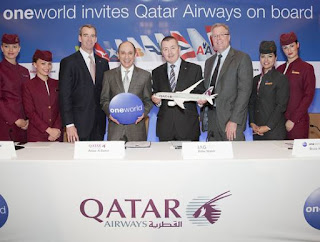Qatar Airways Is Latest in Middle East to Join Alliance
The global airline alliances are moving into the Middle East.
American Airlines and British Airways said Monday that Qatar Airways would join their Oneworld alliance, giving them access to one of the world’s fastest-growing airlines and a modern hub in Doha, the capital of Qatar.
The announcement came just hours after Air France-KLM revealed a commercial partnership with Etihad Airways, based in Abu Dhabi, United Arab Emirates. And last month, Emirates of Dubai, the biggest of the Persian Gulf’s vibrant carriers, announced a wide-ranging combination with Qantas Airlines of Australia.
“It’s a recognition they are taking Gulf carriers seriously after writing them off,” said Akbar Al Baker, the chief executive of Qatar Airways. “When you cannot defeat someone, you’ve got to join them.”
These deals are just the latest in a flurry of global partnerships in recent months. The three big airline coalitions — Star Alliance, SkyTeam and Oneworld — have been busy courting new members in China, Latin America and the Middle East as air travel becomes more global and major business markets expand well beyond the traditional routes between the United States and Europe.
The alliances offer passengers — particularly frequent fliers and business travelers — more destinations, easier connections and the ability to transfer frequent-flier miles among airlines. It also gives them access to business lounges at more airports across the world as well as speedier check-in and boarding.
Formed in the mid-1990s to make connections between flights easier and to offer more destinations than airlines could offer on their own, over time alliances have created deeper bonds among some of their members.
SkyTeam, whose members include Delta Air Lines, Air France-KLM and China Southern, has expanded its partnerships in China, signing on China Eastern and Xiamen Airlines. It added Taiwan’s China Airlines recently. It also brought in Saudi Airlines and Lebanon’s Middle East Airlines. For its part, Star Alliance, the biggest of the three alliances, is adding Shenzhen Airlines of China and EVA Airlines of Taiwan, and also signed big Latin American carriers in June — Copa Airlines and the merged AviancaTaca airline.
The deals with the Middle East carriers signify a major turning point for traditional airlines, which have unsuccessfully tried to fend them off and sought to block their expansion in Europe. Global alliances have filled in big chunks of the world in recent years, but there are still significant white spots on the map, particularly in India and Latin America.
“It’s like the opening phase of Monopoly, where you’re busy buying up property across the board,” said Dominique Patry, the vice president for international affairs and alliances at Air France-KLM. “That work is not entirely over yet.”
But even as the alliances grow, some airlines are still seeking partnerships outside them. Qantas, for instance, is a member of Oneworld, and its deal with Emirates effectively put an end to its longstanding relationship with British Airways, another Oneworld member.
Michael Wisbrun, the managing director of SkyTeam, said the carriers had focused so far on expanding their global footprint. “The focus now,” he added, “will be more on enhancing the customer experience.”
The alliance, he said, recently introduced a service called SkyPriority that will expand to over 1,000 airports by the end of the year. Elite passengers from any alliance airline will get the same priority lanes for checking-in and for boarding, allowing travelers to navigate airports faster, whether in Moscow, Atlanta or Nairobi, Kenya.
Charlie Pappas, the head of alliances at Delta, said: “If you fly to Beijing and then connect to a flight with China Eastern, we seek to replicate Atlanta’s best practices. The same if you fly with Air France to Seoul or with Aeromexico to Amsterdam.”
Some airlines are seeking deeper ties still. Delta, Air France-KLM and Alitalia, for instance, have pooled their trans-Atlantic flights through a joint venture that allows them to coordinate ticket prices, schedules and routes on all their flights between the United States and Europe. They split revenue and costs, and share the profit from the venture, which obtained antitrust immunity from competition regulators in the United States and Europe. The venture generates about $10 billion to $12 billion in revenue a year.
Other airlines have established similar partnerships. United Airlines, Lufthansa and Air Canada operate their trans-Atlantic flights along a similar model, as do American Airlines, British Airways and Iberia. American and JAL also have a joint venture on their United States-Japan routes.
All these new businesses have been helped by open skies agreements that have allowed unrestricted access to airports between the United States and other countries, particularly in Europe. Because of restrictions on foreign ownership, these joint ventures are the closest the airlines can cooperate without merging. In fact, a joint study by the European Commission and the Department of Transportation in November 2010 said these alliances were “effectively a close substitute to a merger.”
Mr. Patry, of Air France, said: “The airline industry remains very fragmented. But, eventually, alliances may be a vehicle for the consolidation of the airline industry. There would be the logical thing.”
Source: http://www.nytimes.com/2012/10/09/business/air-alliances-expand-as-qatar-joins-oneworld.html?_r=0



Comments
Post a Comment